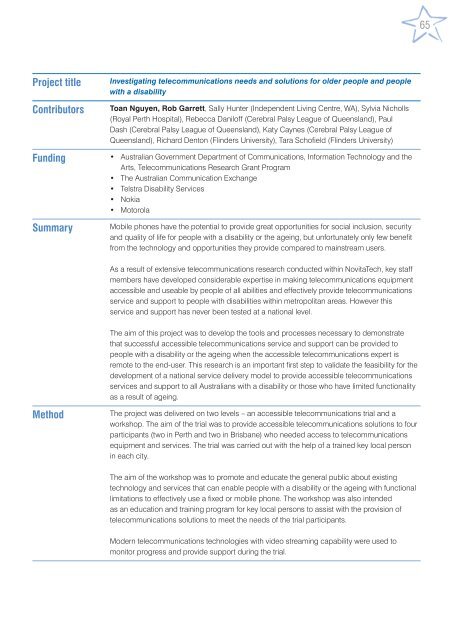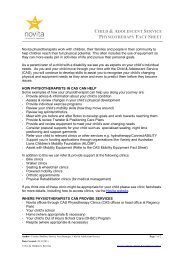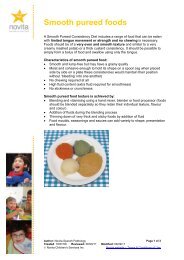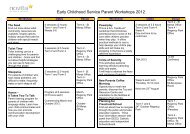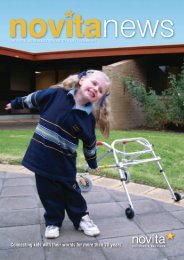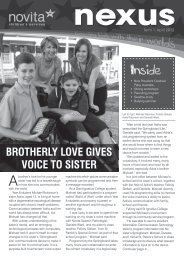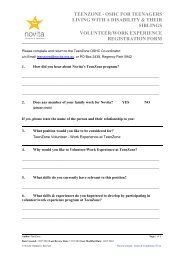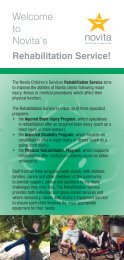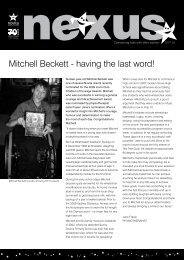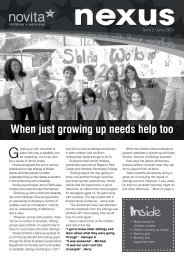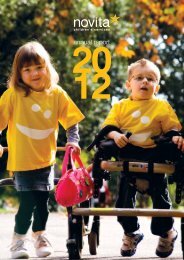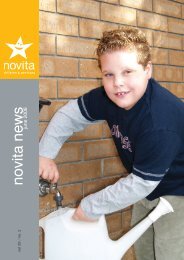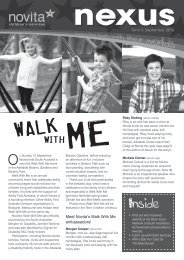64Project titleContribu<strong>to</strong>rsSummaryMethodResultsImplicationsStatusDeveloping a ‘no-<strong>to</strong>uch’ switch and interface for a computer and specialisedcommunication deviceCristina Larenas (Flinders University), Anne-Louise Smith (Flinders Medical Centre), SharmilRandhawa (Flinders University), David Hobbs, Annabel Gregory, Jodie Hobbs (FlindersMedical Centre)For many people with a physical limitation, accessing and interacting with the environment isachieved through the use of a specialised switch. Assistive technology (AT) switches comein all shapes, sizes and functionality, depending on the needs of the user and the device orpiece of equipment that is being controlled. For example, a ‘wand’ switch provides singlelevel switch access for clients who have gross hand or arm function, whereas a ‘sip n puff’switch offers two levels of switching capability and is controlled by the user’s breath.Most switches require a physical press <strong>to</strong> be made <strong>to</strong> activate the switch, while a few offer‘light <strong>to</strong>uch’ or ‘<strong>to</strong>uch but no pressure’ activation when a sustained physical press is difficultfor the client <strong>to</strong> achieve. The aim of this project was <strong>to</strong> develop an easy <strong>to</strong> use ‘no-<strong>to</strong>uch’switch and appropriate interface <strong>to</strong> allow a person with a disability <strong>to</strong> control a computer anda specialised communication device. A no-<strong>to</strong>uch switch would enable someone with a highlevelspinal cord injury, or a condition like ‘locked in syndrome’, who is unable <strong>to</strong> control anyof their limbs or head, <strong>to</strong> be able <strong>to</strong> interact with other specialised devices.The project was jointly initiated by Flinders Biomedical Engineering and <strong>Novita</strong>Tech followingan enquiry about assistance for someone who acquired a brain-stem stroke and was‘locked in’. The project was submitted <strong>to</strong> the Flinders University School of Informatics andEngineering as a Final Year Honours Project for consideration, and was divided in<strong>to</strong> fourstages:1. A literature review of current switches and switch practices, including reviewing knownresources and existing ‘no-<strong>to</strong>uch’ switch methodologies, determining what is being usedand identifying the advantages, disadvantages and shortfalls of current systems2. Investigate current and new methodologies that would enable ‘no <strong>to</strong>uch’ activation andselect a suitable technology3. Design and construct a system using the chosen technology4. Interface the system <strong>to</strong> a computer and existing communication device.After the initial literature review, the focus of the project shifted slightly <strong>to</strong> the important issueof communication at night-time, when the user may need <strong>to</strong> communicate with their carersabout being turned in bed, getting a drink or passing on important information.Eye blinking was seen as one method of alerting the system <strong>to</strong> the fact that the user needsattention, and this activity was targeted using a webcam with infrared (IR) capability incombination with a computer program called MATLAB <strong>to</strong> detect both the eyes and theaction of deliberate blinking. The pro<strong>to</strong>type system that was developed used the fact that eyepupils have a high reflectance under IR illumination <strong>to</strong> identify the eyes, and detected blinksby comparing consecutive frames. The system successfully detected the eyes when testedunder varying conditions, resolutions, illuminations and distances from the camera, but wasless successful when detecting blinking events.The pro<strong>to</strong>type system completed at the end of the academic year demonstrated that acamera with IR capability, when set up appropriately, was reliable at detecting a person’seyes at night-time. The robustness of the overall system, including how the system acquiresand processes real-time information <strong>to</strong> reliably and accurately use blinking as a controlmechanism still needs <strong>to</strong> be explored further and tested. This form of gesture recognitionmay prove <strong>to</strong> be more reliable than existing ‘no-<strong>to</strong>uch’ switch methodologies.Completed
65Project titleContribu<strong>to</strong>rsFundingSummaryInvestigating telecommunications needs and solutions for older people and peoplewith a disabilityToan Nguyen, Rob Garrett, Sally Hunter (Independent Living Centre, WA), Sylvia Nicholls(Royal Perth Hospital), Rebecca Daniloff (Cerebral Palsy League of Queensland), PaulDash (Cerebral Palsy League of Queensland), Katy Caynes (Cerebral Palsy League ofQueensland), Richard Den<strong>to</strong>n (Flinders University), Tara Schofield (Flinders University)• Australian Government Department of Communications, Information Technology and theArts, Telecommunications <strong>Research</strong> Grant Program• The Australian Communication Exchange• Telstra Disability <strong>Services</strong>• Nokia• Mo<strong>to</strong>rolaMobile phones have the potential <strong>to</strong> provide great opportunities for social inclusion, securityand quality of life for people with a disability or the ageing, but unfortunately only few benefitfrom the technology and opportunities they provide compared <strong>to</strong> mainstream users.As a result of extensive telecommunications research conducted within <strong>Novita</strong>Tech, key staffmembers have developed considerable expertise in making telecommunications equipmentaccessible and useable by people of all abilities and effectively provide telecommunicationsservice and support <strong>to</strong> people with disabilities within metropolitan areas. However thisservice and support has never been tested at a national level.The aim of this project was <strong>to</strong> develop the <strong>to</strong>ols and processes necessary <strong>to</strong> demonstratethat successful accessible telecommunications service and support can be provided <strong>to</strong>people with a disability or the ageing when the accessible telecommunications expert isremote <strong>to</strong> the end-user. This research is an important first step <strong>to</strong> validate the feasibility for thedevelopment of a national service delivery model <strong>to</strong> provide accessible telecommunicationsservices and support <strong>to</strong> all Australians with a disability or those who have limited functionalityas a result of ageing.MethodThe project was delivered on two levels – an accessible telecommunications trial and aworkshop. The aim of the trial was <strong>to</strong> provide accessible telecommunications solutions <strong>to</strong> fourparticipants (two in Perth and two in Brisbane) who needed access <strong>to</strong> telecommunicationsequipment and services. The trial was carried out with the help of a trained key local personin each city.The aim of the workshop was <strong>to</strong> promote and educate the general public about existingtechnology and services that can enable people with a disability or the ageing with functionallimitations <strong>to</strong> effectively use a fixed or mobile phone. The workshop was also intendedas an education and training program for key local persons <strong>to</strong> assist with the provision oftelecommunications solutions <strong>to</strong> meet the needs of the trial participants.Modern telecommunications technologies with video streaming capability were used <strong>to</strong>moni<strong>to</strong>r progress and provide support during the trial.


